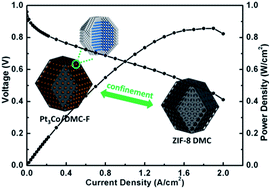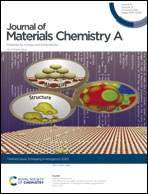Mesoporous carbon confined intermetallic nanoparticles as highly durable electrocatalysts for the oxygen reduction reaction†
Abstract
Exploring advanced electrocatalysts for the sluggish oxygen reduction reaction is extremely important for fuel cell commercialization but still remains a great challenge, especially the durability issue that gains increasing attention. Herein, we demonstrate an extremely durable catalyst prototype that combines structurally ordered intermetallic nanoparticles (NPs) with mesoporous carbon. With ZIF-8 derived mesoporous carbon supported Pt3Co intermetallic NPs (Pt3Co/DMC-F) as an example, we illustrate its synthetic details, electrocatalytic performance and durability enhancement mechanism. The Pt3Co/DMC-F catalyst exhibited significant enhancement in activity and durability. More importantly, its extraordinary performance was observed/verified in a H2/air PEM single cell test. The confinement of mesoporous carbon not only efficiently controls the particle size of Pt3Co and hampers their aggregation during thermal annealing and electrochemical reactions, but also significantly suppresses detachment. Beyond offering an advanced electrocatalyst, this study provides a solution to the durability issue of cathodes that has prevented practical application of proton exchange membrane fuel cells.

- This article is part of the themed collections: Journal of Materials Chemistry A Emerging Investigators and Journal of Materials Chemistry A Lunar New Year collection 2021


 Please wait while we load your content...
Please wait while we load your content...